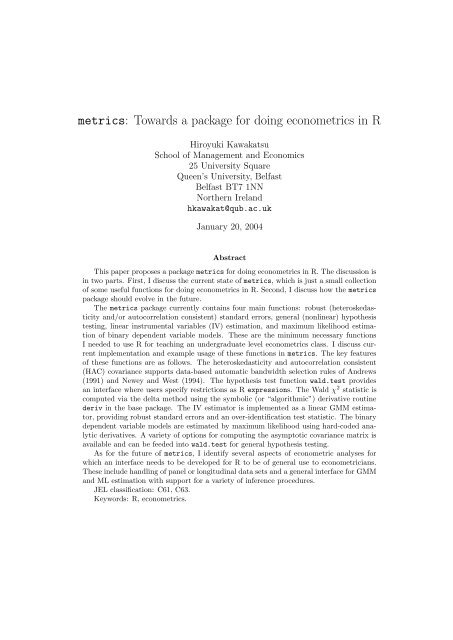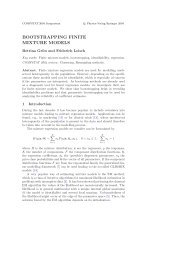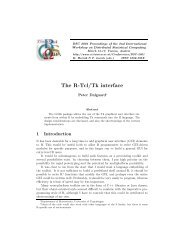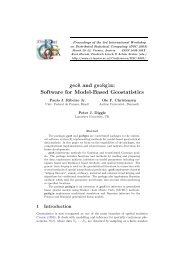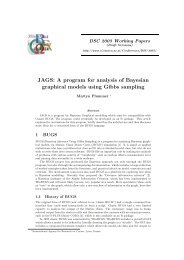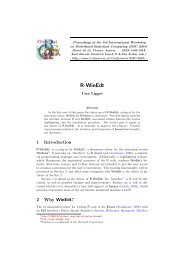Embedding R in Windows applications, and executing R remotely
Embedding R in Windows applications, and executing R remotely
Embedding R in Windows applications, and executing R remotely
You also want an ePaper? Increase the reach of your titles
YUMPU automatically turns print PDFs into web optimized ePapers that Google loves.
metrics: Towards a package for do<strong>in</strong>g econometrics <strong>in</strong> R<br />
Hiroyuki Kawakatsu<br />
School of Management <strong>and</strong> Economics<br />
25 University Square<br />
Queen’s University, Belfast<br />
Belfast BT7 1NN<br />
Northern Irel<strong>and</strong><br />
hkawakat@qub.ac.uk<br />
January 20, 2004<br />
Abstract<br />
This paper proposes a package metrics for do<strong>in</strong>g econometrics <strong>in</strong> R. The discussion is<br />
<strong>in</strong> two parts. First, I discuss the current state of metrics, which is just a small collection<br />
of some useful functions for do<strong>in</strong>g econometrics <strong>in</strong> R. Second, I discuss how the metrics<br />
package should evolve <strong>in</strong> the future.<br />
The metrics package currently conta<strong>in</strong>s four ma<strong>in</strong> functions: robust (heteroskedasticity<br />
<strong>and</strong>/or autocorrelation consistent) st<strong>and</strong>ard errors, general (nonl<strong>in</strong>ear) hypothesis<br />
test<strong>in</strong>g, l<strong>in</strong>ear <strong>in</strong>strumental variables (IV) estimation, <strong>and</strong> maximum likelihood estimation<br />
of b<strong>in</strong>ary dependent variable models. These are the m<strong>in</strong>imum necessary functions<br />
I needed to use R for teach<strong>in</strong>g an undergraduate level econometrics class. I discuss current<br />
implementation <strong>and</strong> example usage of these functions <strong>in</strong> metrics. The key features<br />
of these functions are as follows. The heteroskedasticity <strong>and</strong> autocorrelation consistent<br />
(HAC) covariance supports data-based automatic b<strong>and</strong>width selection rules of Andrews<br />
(1991) <strong>and</strong> Newey <strong>and</strong> West (1994). The hypothesis test function wald.test provides<br />
an <strong>in</strong>terface where users specify restrictions as R expressions. The Wald χ 2 statistic is<br />
computed via the delta method us<strong>in</strong>g the symbolic (or “algorithmic”) derivative rout<strong>in</strong>e<br />
deriv <strong>in</strong> the base package. The IV estimator is implemented as a l<strong>in</strong>ear GMM estimator,<br />
provid<strong>in</strong>g robust st<strong>and</strong>ard errors <strong>and</strong> an over-identification test statistic. The b<strong>in</strong>ary<br />
dependent variable models are estimated by maximum likelihood us<strong>in</strong>g hard-coded analytic<br />
derivatives. A variety of options for comput<strong>in</strong>g the asymptotic covariance matrix is<br />
available <strong>and</strong> can be feeded <strong>in</strong>to wald.test for general hypothesis test<strong>in</strong>g.<br />
As for the future of metrics, I identify several aspects of econometric analyses for<br />
which an <strong>in</strong>terface needs to be developed for R to be of general use to econometricians.<br />
These <strong>in</strong>clude h<strong>and</strong>l<strong>in</strong>g of panel or longitud<strong>in</strong>al data sets <strong>and</strong> a general <strong>in</strong>terface for GMM<br />
<strong>and</strong> ML estimation with support for a variety of <strong>in</strong>ference procedures.<br />
JEL classification: C61, C63.<br />
Keywords: R, econometrics.


